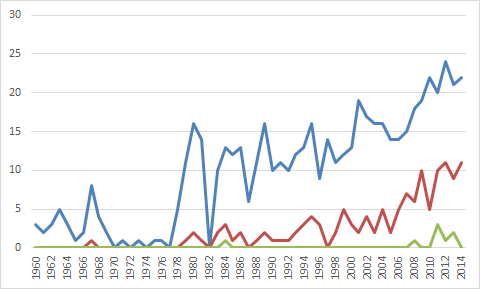Adam Steele is back for another guest post. And, as always, we thank him for that. You can view all of Adam’s posts here.
During the 2014 season, Chase noted that the league-wide touchdown pass rate was the highest it had been since the NFL merger. The final few weeks of the season dragged down the average a little bit, but 2014 still checks in as the most touchdown pass friendly year in NFL history. In response, a few commenters cited the possibility that teams were tallying more TD passes by sacrificing TD runs, which is a logical conclusion considering the very low rate of rushing touchdowns in 2014 (teams averaged 0.74 per game, the lowest since 1999). Today, I’m going to look into this further and see if teams really are inflating their passing TD numbers at the expense of the run.
First, we have to establish a historical baseline, and I did this by looking at every NFL season since 1950. In that time frame, teams averaged 2.26 offensive touchdowns per game, with 1.35 of those coming via the pass and 0.91 via the run. Translated into a ratio, offensive touchdowns have historically been 59.6% passing and 40.4% rushing. That 59.6% is the key number here, as it will be the baseline ratio for expected passing touchdowns. Below is a chart containing relevant information for each year since 1950. The “PaTD %” column represents the percentage of offensive touchdowns in a given year that were scored via the pass, and the “Inflation” column compares that year’s passing TD ratio with the historical average of 59.6%.
As you can see, 2014 really did feature highly inflated passing TD totals, with 68.0% of offensive touchdowns coming through the air. This trend began in 2010, stabilized for four years, then jumped again significantly last season. The most obvious explanation is that teams are now passing more in general, so it would follow that they would also pass more to score touchdowns. But that’s only part of the story, as the rate of passing touchdowns has far outstripped the rate of overall called passes.
The main culprit appears to be goal line play selection, which has heavily favored the pass in recent seasons. Interestingly, from 1997-2009, there was no trend whatsoever, with passing TD ratios jumping around randomly from season to season. From 1980-1994, passing TD ratios were slightly lower, yet still very random. Even during the dead ball era of the 1970s, when the rules made passing far more difficult than it is today, teams still scored more often with passes than they did with runs. In fact, the famous 1956 season was the only time in the last 65 years where teams scored more rushing touchdowns than passing touchdowns.
But here’s what fascinates me the most: Despite the huge increases in total yardage and passing efficiency in recent years, offensive touchdowns have increased very little. In 2014, teams scored only 0.06 more offensive touchdowns than the historical average. In fact, the top 15 seasons for offensive TD production all came before the merger! If the NFL had been playing a 16 game schedule in the ’50s and ’60s, TD pass totals would be very similar to what we see today, and rushing TD totals would be higher.
So how does all this affect touchdown records for various quarterbacks? Since the 16 game schedule began in 1978, there have been 51 teams who scored at least 50 offensive touchdowns in a given season. Of those 51 teams, 33 of them had passing TD ratios above the historical average of 59.6%. In this chart, I list the primary QB, although the numbers represent team totals. The “Adjusted Pass TD” column is calculated by multiplying offensive touchdowns by .596, calculating how many TD passes would have been thrown by sticking with the historical average ratio. The “Change” column represents the difference in adjusted TD passes compared to actual TD passes, basically measuring how many TD pass were vultured from the run game.
I have plenty of thoughts about this chart, but I’m more interested to see what the readers think. Does this analysis change your opinion of any of these great QB seasons?








